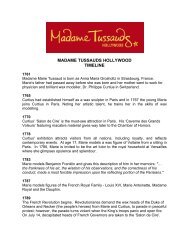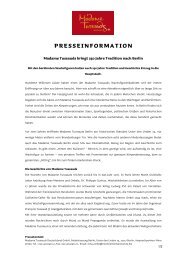What is a portrait? - Madame Tussauds
What is a portrait? - Madame Tussauds
What is a portrait? - Madame Tussauds
Create successful ePaper yourself
Turn your PDF publications into a flip-book with our unique Google optimized e-Paper software.
Activity 1<br />
a<br />
b<br />
When you have fin<strong>is</strong>hed your self-<strong>portrait</strong>, look at it closely.<br />
Does it look like you? If not, why not? <strong>What</strong> could you<br />
develop or alter to make it look even better?<br />
Swap <strong>portrait</strong>s with the person sitting next to you. <strong>What</strong><br />
are the best things about their <strong>portrait</strong>? Give them some<br />
tips on how they might develop it further.<br />
Activity 2<br />
Many art<strong>is</strong>ts have created self-<strong>portrait</strong>s which show their<br />
mood or feelings (e.g. Picasso, Rembrandt, Van Gogh).<br />
Create a self-<strong>portrait</strong> that expresses a particular feeling or<br />
mood. You could use colour, marks and textures to suggest<br />
what that feeling or mood might be.<br />
For example:<br />
1<br />
2<br />
3<br />
4<br />
Dark, heavy marks or sharp shapes might suggest anger or pain.<br />
Pale, delicate marks might suggest uncertainty.<br />
Pale colours or a lot of blue might suggest sadness or calm.<br />
A lot of bright, vibrant colours might suggest happiness.<br />
You might also like to use symbols to suggest a mood or emotion.<br />
Look at the work of Frida Kahlo. She was a Mexican art<strong>is</strong>t who<br />
experienced a lot of physical and emotional pain in her life and<br />
she often used symbols in her work to reflect that pain.<br />
Activity 3<br />
Write a poem to go with your painting,<br />
expressing the same feeling or mood.<br />
Activity 4<br />
Swap self-<strong>portrait</strong>s with one of your<br />
classmates and evaluate each other’s<br />
work. Think about the following:<br />
Can you tell what mood or emotion<br />
<strong>is</strong> shown in the image?<br />
Is the composition of the picture<br />
effective?<br />
Symbols<br />
Evaluation<br />
Developing a<br />
self-<strong>portrait</strong><br />
Art top tips<br />
Make a number of observational studies of yourself using different drawing<br />
media. Look at how your face changes depending on your expression.<br />
Creating a likeness of somebody, especially yourself, <strong>is</strong> a challenge, but fun.<br />
The more you practice though, the better you will get!<br />
Looking at, and analysing other art<strong>is</strong>ts’ work <strong>is</strong> a great<br />
way of developing your own personal style. V<strong>is</strong>it as many<br />
galleries as you can and do research online, making<br />
notes and sketches on their styles and techniques all<br />
the time. The National Portrait Gallery’s website <strong>is</strong> a<br />
good source of information www.npg.org.uk<br />
Key words<br />
Style<br />
Vibrant<br />
Texture<br />
1<br />
Pablo Picasso:<br />
Self <strong>portrait</strong> 1901<br />
Credit: The Granger<br />
Collection / TopFoto<br />
2<br />
Pablo<br />
Picasso:<br />
Self Portrait<br />
at Age 26<br />
Credit: The Granger<br />
Collection / TopFoto<br />
Worksheet










